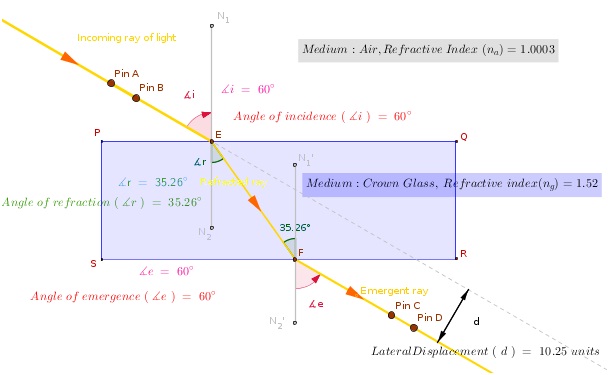





Published on Apr 02, 2024
As light travels through a given medium, it travels in a straight line. However, when light passes from one medium into a second medium, the light path bends. Refraction takes place. The refraction occurs only at the boundary. Once the light has crossed the boundary between the two media, it continues to travel in a straight line. Only now, the direction of that line is different than it was in the former medium. If when sighting at an object, light from that object changes media on the way to your eye, a visual distortion is likely to occur. This visual distortion is witnessed if you look at a pencil submerged in a glass half-filled with water. As you sight through the side of the glass at the portion of the pencil located above the water's surface, light travels directly from the pencil to your eye. Since this light does not change medium, it will not refract.
To trace the course of different rays of light through a rectangular glass slab at different angles of incidence, measure the angle of incidence, refraction and verify Snell`s law. Also measure the lateral displacement.
• We know about light and also know that light travels in a straight line path in a medium or two different mediums with same density.
• Now a question arises what happens when light travels from one medium to another with different densities for example from air to glass.
• When light ray is made to travel from one medium to another say from air to glass medium then light rays bend at the boundary between the two mediums.
• So, the bending of light when it passes from one medium to another is called Refraction of light.
• The refraction of light takes place on going from one medium to another because the speed of light is different in two media.
• Medium in which speed of light is more is called optically rarer medium and medium in which speed of light is less is known as optically denser medium. For example glass is an optically denser medium than air and water.
NOTE:- When light goes from rarer medium to denser medium it bends towards the normal and when it goes from denser medium to rarer medium it bends away from the normal.
A drawing board, rectangular glass slab, office pins, sheet of white paper, a protractor and sharply pointed pencil.
1. Fix a sheet of white paper on a drawing board with drawing pins. Place the given glass slab nearly in the middle of the sheet.
2. Mark the boundary of the glass slab with a sharp pencil and label it as PQRS after removing the slab from its position.
3. On the line PQ mark a point E and draw a normal N1EN2 at it. Draw a line AE making angle AEN1 with the normal.The angle should neither too small nor too large (say about 40 degree).
4. Now place the glass slab again on its boundary PQRS and fix two pins A and B vertically about 10 cm apart on the line AE (say points A and B).
5. Look through the glass slab along the plane of the paper from the side SR and move your head until the images of the two pins A and B are seen clearly. Closing your one eye ,adjust the position of your head in such a way that the images of the pins A and B lie in the same straight line.
6. Fix two other pins C and D vertically in such a way that the images of the pins A and B and pins C and D, all these four, lie in the same straight line. Ensure that the feet of the pins ( not their heads ) lie in the same straight line.
7. Remove the slab and also the pins from the board and encircle the pin-pricks on the paper,with a sharp pencil.
8. Join the points D and C and produce the line DC towards the slab so that it meets the boundary line RS at the point F. Join the points e and F. Thus for the incident ray represented by line AE, the refracted ray and the emergant ray are represented by EF and FD respectively.
9. On the line RS draw a normal N1'FN2' at point F. Now, with a protractor, measure angle AEN1, angle FEN2 and angle DFN2' labelled as angle i, angle r and angle e respectively.
10. Now place the glass slab at some other position on the sheet of paper fixed on the board and repeat all the above steps again taking another angle of incidence.
11. Measure the angle of incidence i.e angle of refraction, angle of emergence, again.
12. Make a record of your observations in the observation table as shown below.


It is clear from the observation table that the ratio of Sini and Sinr is constant. Hence Snell`s is law verified.
• http://www.physicstutorials.org/home/optics/reflection-of-light/curved-mirrors/concave-mirrors/image-formation-in-concave-mirrors
• http://farside.ph.utexas.edu/teaching/302l/lectures/node137.html
• http://www.tutorvista.com/content/science/science-ii/reflection-light/formation-concave-mirror.php